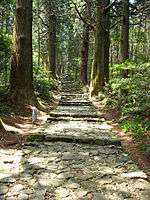Kumano Kodō
The Kumano Kodō (熊野古道) is a series of ancient pilgrimage routes that crisscross the Kii Hantō, the largest Peninsula of Japan. These sacred trails were and are used for the pilgrimage to the sacred site "Kumano Sanzan" (熊野三山) or the Three Grand Shrines of Kumano: Kumano Hongū Taisha (熊野本宮大社), Kumano Nachi Taisha (熊野那智大社) and Kumano Hayatama Taisha (熊野速玉大社).
The Kumano Kodō pilgrimage routes that lead to Kumano can be categorized into three sub-routes: Kiji, Kohechi and Iseji. The Kumano Kodō and Kumano Sanzan, along with Koyasan and Yoshino and Omine, were registered as World Heritage sites on July 7, 2004 as the "Sacred Sites and Pilgrimage Routes in the Kii Mountain Range."[1]
Kiji route
The "Kiji" route runs along the west coast of the peninsula to the city of Tanabe where it forks into two: Nakahechi and Ohechi. The Nakahechi route leads into the rugged interior mountains toward Kumano Hongū Taisha and the Ohechi continues south along the coast. The Nakahechi route was the most popular for pilgrimages from Kyoto, the ancient capital of Japan. The earliest records of this route dates from the early 10th century. The trail has a long history of use by people with diverse belief backgrounds leading to mixed religious symbolism overlaid and incorporated into the setting and stages of the pilgrimage itself.
The UNESCO World Heritage registered section begins at Takijiri-oji which is considered to be the point of entry to the sacred area of Kumano. From here it is about 40 km of mountainous trail before one reaches the mystical Kumano Hongū Taisha. Most pilgrimages break the journey into a two-day walk. The Chikatsuyu-oji is about halfway and most pilgrims stay the night here at a minshuku.
In Hongū, pilgrims often did purification rites in Yunomine Onsen (Yunomine hot spring). Tsuboyu is a small cabin on the creek that runs through this isolated village, featuring a small rocky bath that is the only World Heritage hot spring open to visitors. The bath was used for purification rites and its legendary healing effects.
The Kumano Kodō Dainichi-goe route links Kumano Hongū Taisha with Yunomine. It is 2 km long and is a steep climb, and descends over a small pass.
From Kumano Hongū Taisha most pilgrims went by boat on the Kumano River to Kumano Hayatama Taisha in the coastal town of Shingū. This 40 km section of the Kumano Kodō is the only river pilgrimage route that is registered as a World Heritage site. There is an overland route that links Kumano Hongū Taisha with Kumano Nachi Taisha. Most pilgrims take two days to complete this walk staying in the small town of Koguchi. The section between Hongū and Koguchi is called the Kogumotori-goe and the section between Koguchi and Kumano Nachi Taisha is called Ogumotori-goe.
Kohechi route
The "Kohechi" route links Koyasan to the Kumano Sanzan. It runs north to south and is 70 km long. It is the shortest route connecting Koyasan to Kumano but is a tough walk that traverses three passes of over 1,000 meters.
Iseji route
The "Iseji" route links Ise Grand Shrine with the Kumano Sanzan. It was not until the 17th century that this route became part of the Saikogu pilgrimage, the first temple being Seiganto-ji, which is closely related with the Kumano Nachi Taisha.
The "Magose Toge" forms the boundary between Miyama, Kyoto and Owase, Mie. A moss-covered stone path stretches about 2 km into the beautiful cypress forest covered with ferns. This route leads to Tengura-san with a huge stone at the tip. There is a small tunnel below the stone one can enter. From the stone, there is a scenic view of Owase City. Magose-koen Park on the way down the pass is renowned for its cherry blossoms.[2]
Gallery
 Map of Kumano Kodō
Map of Kumano Kodō Daimonzaka
Daimonzaka Gyubadouji
Gyubadouji Part of the Kumano Kodō near Yunomine Onsen
Part of the Kumano Kodō near Yunomine Onsen Traveler on the Kumano Kodō
Traveler on the Kumano Kodō Kumano Kodo near Hosshinmon-oji
Kumano Kodo near Hosshinmon-oji Small shrine near Takahara village
Small shrine near Takahara village Kumano Kodo near Tsugizakura-oji
Kumano Kodo near Tsugizakura-oji Kami stone near Hisohara-oji
Kami stone near Hisohara-oji An old milestone for 1 ri — around 4 km, on Kumano Kodo.
An old milestone for 1 ri — around 4 km, on Kumano Kodo. The route near the Hongu taisha.
The route near the Hongu taisha. Kami figure inside the small shrine at Inohana-oji.
Kami figure inside the small shrine at Inohana-oji.
See also
References
- ↑ UNESCO. "Sacred Sites and Pilgrimage Routes in the Kii Mountain Range". Retrieved 2007-11-30.
- ↑ Revival of the Ancient Pilgrimage Road
Kumano Kodo Travel Guide, 200km trails, 16'000m altitude, 60hrs hiking, Beumer, Hans. 2016